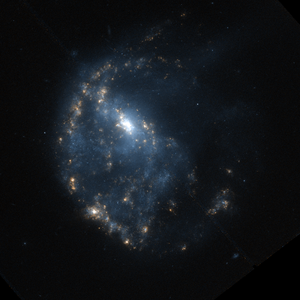NGC 922
| Galaxy NGC 922 |
|
|---|---|

|
|
| Image of the Hubble Space Telescope with the WFC3 instrument | |
| AladinLite | |
| Constellation | Chemical furnace |
|
Position equinox : J2000.0 , epoch : J2000.0 |
|
| Right ascension | 02 h 25 m 04.4 s |
| declination | -24 ° 47 ′ 17 ″ |
| Appearance | |
| Morphological type | SB (s) cd / pec |
| Brightness (visual) | 11.8 mag |
| Brightness (B-band) | 12.5 mag |
| Angular expansion | 2 ′ × 1.6 ′ |
| Position angle | 172 ° |
| Surface brightness | 12.9 mag / arcmin² |
| Physical data | |
| Redshift | 0.010270 ± 0.000087 |
| Radial velocity | 3063 ± 26 km / s |
|
Stroke distance v rad / H 0 |
(135 ± 9) · 10 6 ly (41.5 ± 2.9) Mpc |
| history | |
| discovery | Wilhelm Herschel |
| Discovery date | November 17, 1784 |
| Catalog names | |
| NGC 922 • UGC A 30 • PGC 9172 • ESO 478-G028 • MCG -04-06-37 • IRAS 02228-2500 • 2MASX J02250439-2447174 • SGC 022248-2500.9 • GC 540 • H III 239 • h 2478 • AM 0222 -250 • HIPASS J0224-24 | |
NGC 922 is a barred spiral galaxy of the Hubble type SB (s) cd in the constellation Fornax in the southern sky , which is an estimated 135 million light years away from the Milky Way . Their ring-shaped structure goes back to a galaxy collision around 300 million years ago. In the X-ray light several bright knots, probably by showing black extinguisher caused.
The object was discovered on November 17, 1784 by the German-British astronomer Wilhelm Herschel .
Web links
Commons : NGC 922 - collection of images, videos, and audio files
- The Star Cluster Population of the Collisional Ring Galaxy NGC 922
- Chandra Observations of the Collisional Ring Galaxy NGC 922 , bibcode : 2012ApJ ... 747..150P
- Ultra-luminous X-ray Sources
- NASA's Chandra X-ray Observatory, Black Hole Considerations
- NGC 922: Collisional Ring Galaxy
